A traditional trademark consists of letters, numerals, words, pictures, symbols, or a combination of one or more of these elements. In contrast, a nontraditional trademark is one that consists of colors, sounds, or smells, any combination of such signs, or position marks (marks that appear in a particular position on a product). Although no such distinction exists under the Trade Marks Ordinance Cap. 559 (TMO) of the laws of Hong Kong, the Hong Kong Trade Marks Registry (Registry) seems to adopt a stricter requirement of distinctiveness for nontraditional marks (NTMs).
The TMO provides for the registration of smells, shape marks, colors, and sounds, and, with the exception of smells, these marks have been successfully registered for some time in Hong Kong. Other NTMs, such as position marks, movement marks, and hologram marks, are not specified under the TMO but are nonetheless allowed for registration.
That being said, a trend of objections and refusals of NTMs comprised of position marks or color marks (single color marks or those of two or more colors) has recently emerged. This trend may indicate a more stringent approach toward the examination of NTMs. This article explores these recent trends and the treatment of these two types of NTMs.
Position Trademarks
A position trademark is a type of NTM consisting of the specific way in which the trademark is placed on or affixed to the product. It is commonly found in relation to shoes and clothing.
Generally, position marks are perceived as nondistinctive because they appear to be decorative or functional elements of the product. Applicants can overcome this objection by filing evidence of use in Hong Kong to prove that the mark has acquired distinctiveness. Below are examples of two marks that have been accepted based on evidence of use for footwear in Class 25:
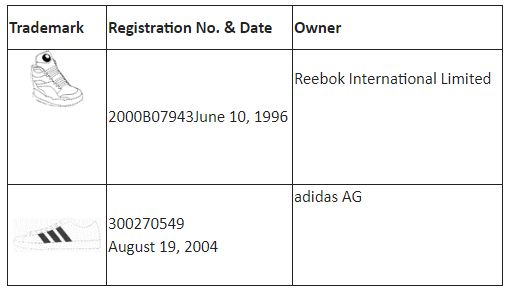
Not all position marks are registered based on distinctiveness acquired through use. Below are three examples of position marks registered for footwear in Class 25 without the need to submit evidence of use:
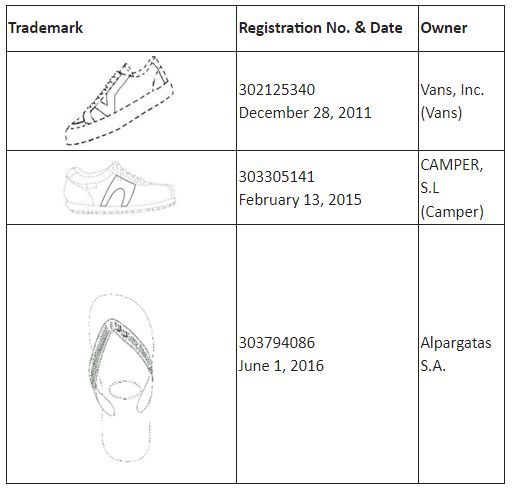
Where a position mark consists of a house mark or other distinctive word or device elements, generally the mark as a whole would be considered as distinctive, as seen in the above mark registered by Alpargatas S.A. containing the word "havaianas" and a pattern on the mark. The other two examples of position marks registered by Vans and Camper without any word or device elements tend to be the exception rather than the rule.
"Generally, position marks are perceived as nondistinctive because they appear to be decorative or functional elements of the product."
In some instances, even with the submission of evidence, the Registry has refused applications for position marks as it does not find that the evidence submitted is sufficient to prove that the mark has become distinctive as a result of the use made of it in Hong Kong. Below are two position marks applied for by Vans for footwear in Class 25 that the Registry has refused, with its reasoning also summarized below:
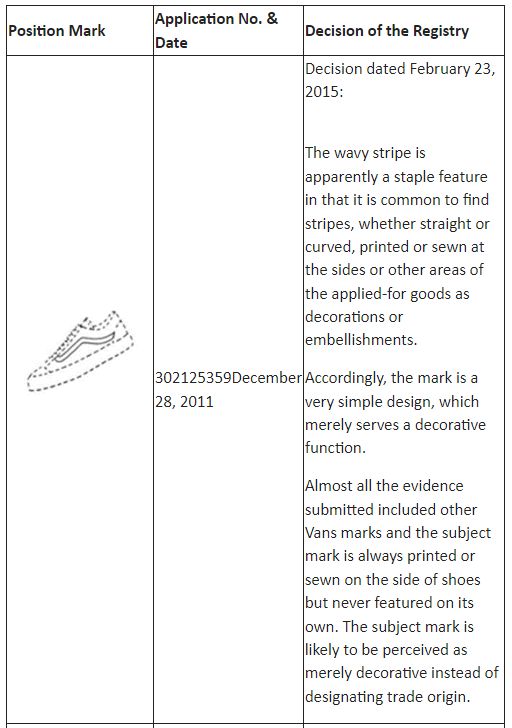
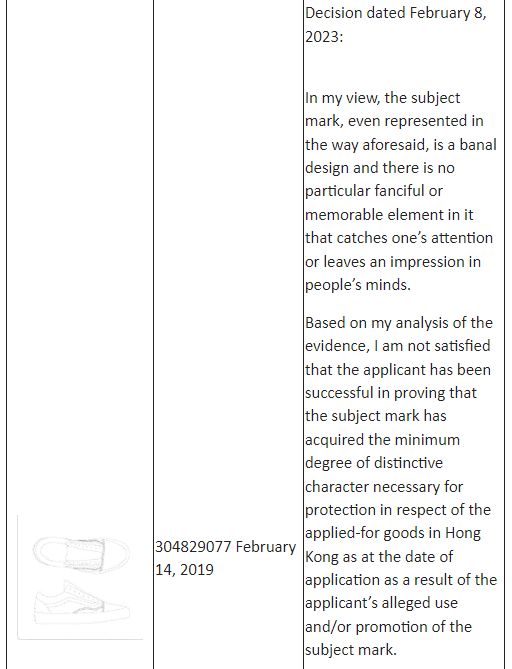
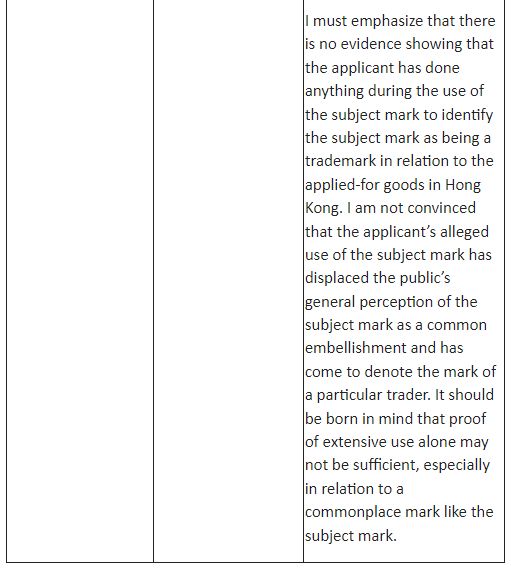
Position marks are also commonly used on clothing and the registrability of the marks depends on the design or the trademark positioned on the product, as seen in the examples below:
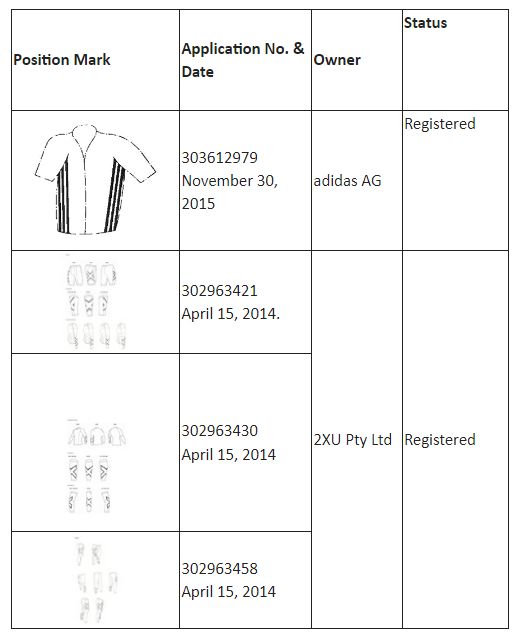
Lessons for Position Mark Applicants
Generally, position marks will face registrability objections. Brand owners need to submit a substantial amount of evidence of use and take extra steps to highlight the relevant trademark in its promotional materials, such as adding the TM symbol next to the mark in question.
Color Trademarks
Single Color Marks
Trademarks consisting solely of color or colors are registrable if capable of distinguishing and being distinctive. A mark's capability to distinguish depends on the customary use of the mark as an indication of origin in the industry concerned and the views of relevant consumers.
Consumers are generally not accustomed to making assumptions about the source of goods based only on the color of the goods or their packaging and must rely on additional graphic or text elements.
"The burden of use is substantial, and as far as we are aware, no applicant has been successful in registering a single color block for goods."
If an applicant can establish acquired distinctiveness, the applicant may be able to register a single color mark for very specific goods or goods intended for a specific clientele or for a very unusual and peculiar shade or color in the relevant trade. The burden of use is substantial, and as far as we are aware, no applicant has been successful in registering a single color block for goods.
Tiffany & Co. (Tiffany) attempted to register its blue color trademark shown below:
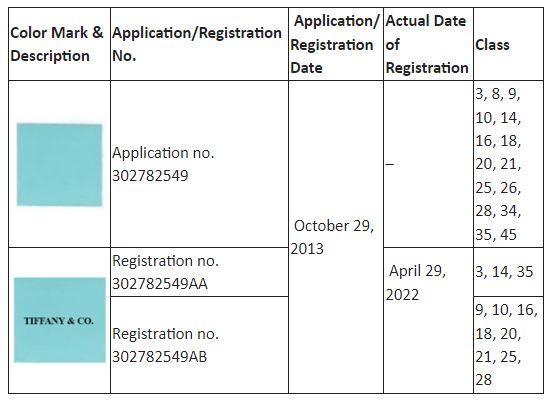
The blue color trademark the company applied for in October 2013
was registered after eight years in April 2022 in the form ![]() with the mark TIFFANY & CO. Tiffany has
been long established in Hong Kong, and the eventual registration
of the blue mark with the distinctive house mark illustrates the
difficulty and challenge in registering a single color mark.
with the mark TIFFANY & CO. Tiffany has
been long established in Hong Kong, and the eventual registration
of the blue mark with the distinctive house mark illustrates the
difficulty and challenge in registering a single color mark.
Trademarks consisting of a single line of color lack the ability to distinguish goods of one trader from goods of others or are considered merely decorative features applied onto the goods and indistinctive for registration.
Below are examples of recent attempts to register single color marks which the Registry has objected to:
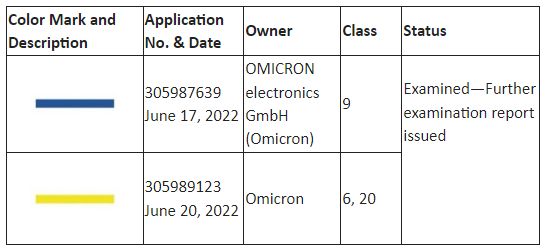
Marks Consisting of Two or More Colors
Trademarks having two or more colors combined have more distinctiveness and are generally registrable without acquired distinctiveness. Actual registrability depends on the presentation of the colors in the mark, the goods or services concerned, and public perception.
Below are examples of trademarks with two or more colors registered without acquired distinctiveness:
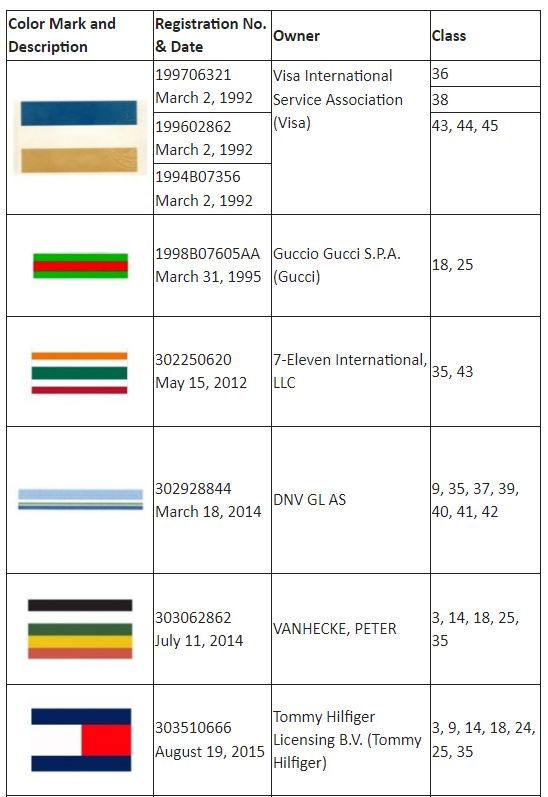
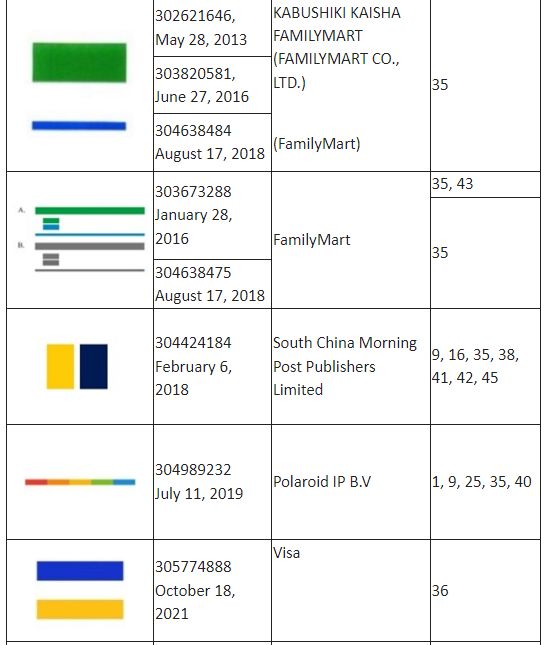
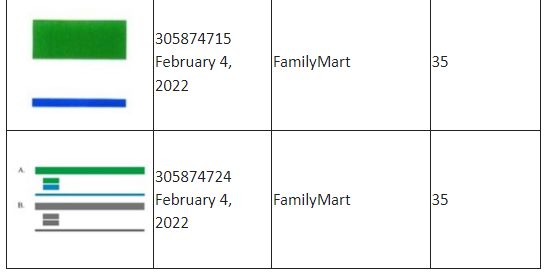
Trademarks having two or more colors in the form of horizontal
or vertical stripes in Classes 18 and 25 have been registered for
bags, clothing, and footwear without use—for example,
Gucci's 1995 registration for ![]() , for three green and red horizontal stripes.
Gucci also has a 2004 registration for
, for three green and red horizontal stripes.
Gucci also has a 2004 registration for ![]() , for three red and blue vertical stripes
(Registration no. 300217647), which was registered for use.
, for three red and blue vertical stripes
(Registration no. 300217647), which was registered for use.
Below are applications of marks having two or more colors, which the Registry either objected to or refused:
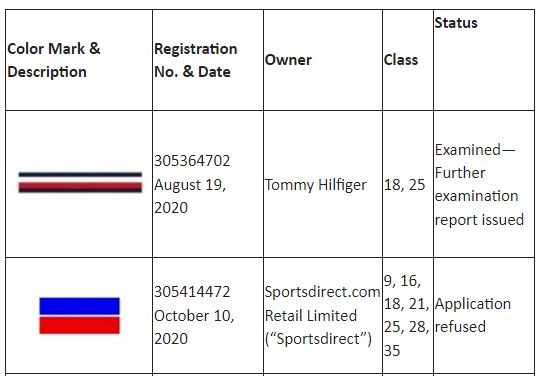
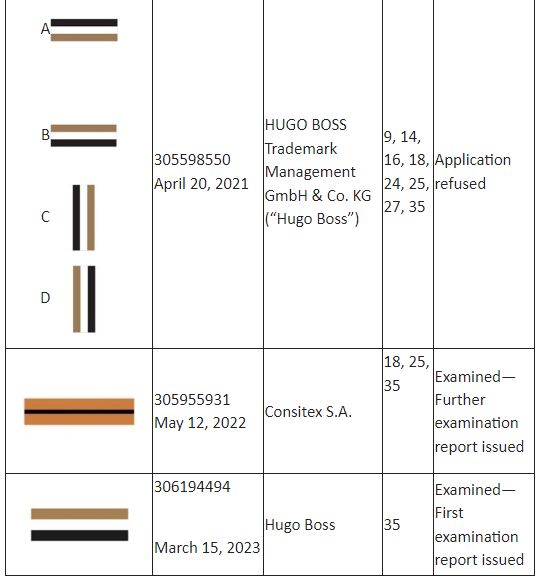
The Registry objected to Tommy Hilfiger's mark ![]() , claiming three colors despite the brand
owner's earlier registration for
, claiming three colors despite the brand
owner's earlier registration for  , claiming two colors. The refused mark
, claiming two colors. The refused mark  , claiming blue and red that Sportsdirect
filed in 2020, was registered on use in the UK in 2021 in Class 35
for retail services relating to Class 18 and Class 25 goods.
, claiming blue and red that Sportsdirect
filed in 2020, was registered on use in the UK in 2021 in Class 35
for retail services relating to Class 18 and Class 25 goods.
"Trademarks having two or more colors combined have more distinctiveness and are generally registrable without acquired distinctiveness."
The Registry refused Hugo Boss's application for this mark
![]() in April 2021 which claimed the
colors camel, white, and black. The company refiled in March 2023
without a color claim, in Class 35 for retail stores, relating to
clothing, footwear, headgear, and fashion accessories, and again
faced objection.
in April 2021 which claimed the
colors camel, white, and black. The company refiled in March 2023
without a color claim, in Class 35 for retail stores, relating to
clothing, footwear, headgear, and fashion accessories, and again
faced objection.
The trend for objections highlights that the Registry is conducting stricter examinations of marks having two or more colors in the form of stripes intended for use on bags, clothing, and footwear, because such use can be considered merely for decorative purposes, rather than as a badge of origin.
Lessons for Color Trademark Applications
Trademarks consisting of a single color lack capacity to distinguish, and evidence of use— even long use in Hong Kong—may be insufficient to establish distinctiveness through use in Hong Kong.
Trademarks consisting of two or more colors are generally registrable, although colors in the form of stripes may lack distinctiveness if intended to be used as decorative stripes of color on clothing, bags, and footwear. However, the greater the combination of colors, the more distinctive the mark.
Originally published on INTA: https://www.inta.org/perspectives/features/what-you-should-know-about-registering-nontraditional-trademarks-in-hong-kong/
The content of this article is intended to provide a general guide to the subject matter. Specialist advice should be sought about your specific circumstances.

